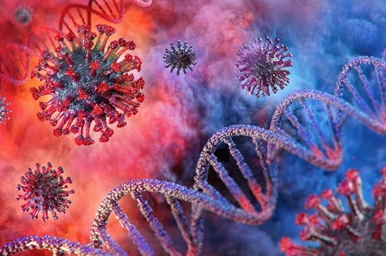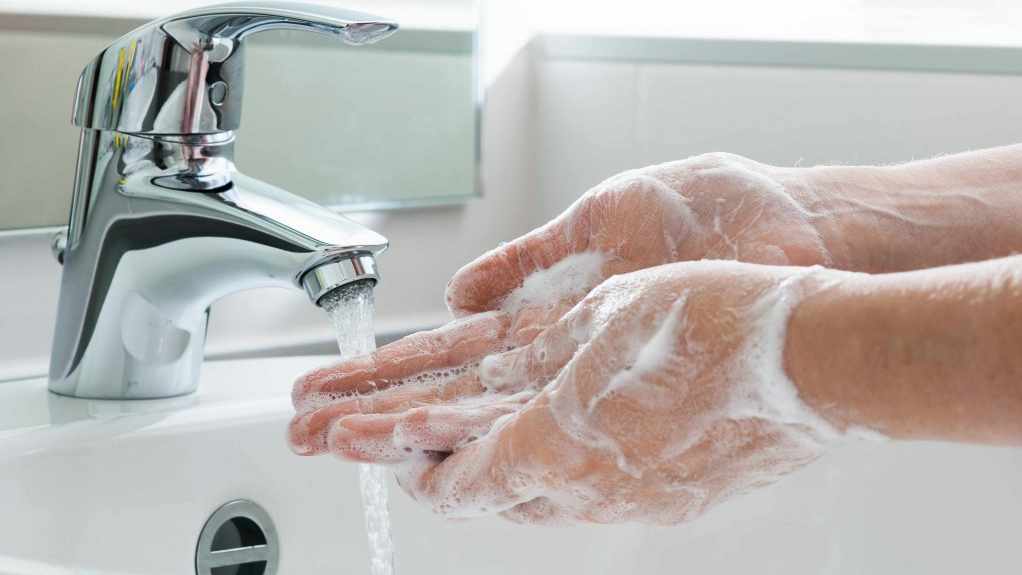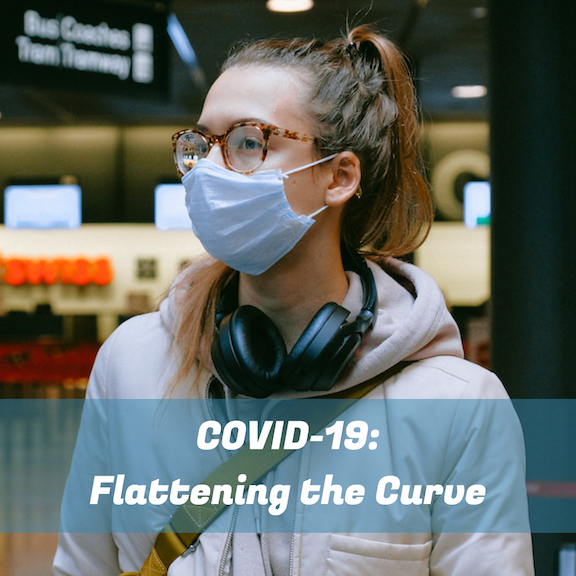Coronavirus (COVID-19 or Sars-CoV-2) has been called by the World Health Organization (WHO) as a “defining global health crisis of our time.” COVID-19 is still a new disease and organizations like WHO and the Centers for Disease Control and Prevention (CDC) are still learning how it spreads, the severity, and to what extent it may spread through the United States. These are great resources to find factual information on what is truly going on today, and how to stay healthy in the COVID-19 pandemic.
What is COVID-19?

Coronaviruses are a family of viruses that are common in both people and animals. It is rare that animal coronaviruses infect people and then spread, but that is the case with this new coronavirus. This new virus (Sars-CoV-2) originating in Wuhan, China, is a beta coronavirus whose origin lies in bats, and sequences seen in U.S. patients suggest the emergence of this virus from a single animal reservoir. Many states in the US as well as countries across Europe have closed schools, entertainment venues, casinos, restaurants, and all but essential personnel in order to fight the virus.
Symptoms of COVID-19:
- Fever
- Cough
- Shortness of breath
Symptoms have thus far ranged from mild to severe, or death depending on a few caveats, and they usually appear 2-14 days after exposure.
People most at risk of severe symptoms:
- Older adults
- People who have compromised immune systems and have chronic medical conditions such as heart disease, diabetes, and lung disease.
The virus is thought to spread from person to person between those who are in close contact (within 6 feet of each other), and done so through respiratory droplets given off when an infected person coughs or sneezes which is the main way the virus is thought to spread. According to the CDC, individuals are thought to be the most contagious when they are at their sickest, but some spread may be possible before symptoms emerge. They also state that a person could potentially contract COVID-19 by touching a surface or object that has the virus on it, then proceeding to touch their mouth, nose, or eyes. However, viral spread before symptoms show and touching surfaces with the virus are not thought to be the main ways the COVID-19 spreads.
How to Protect Yourself & Others from COVID-19

Since there is currently no vaccine to prevent COVID-19, the best way to prevent illness is to avoid being exposed to the virus.
Necessary steps to protect yourself:
- Wash your hands often – this means washing them often with soap & water for at least 20 seconds especially after being in a public place, coughing, sneezing, or blowing your nose. If soap & water is not readily available, be sure to use hand sanitizer that contains 60% alcohol. Additionally, avoid touching your eyes, mouth, and nose with unwashed hands.
- Avoid close contact – avoid anyone who may be sick. This also means practicing social distancing by the CDC standard which is at least being 6 feet away from someone else, especially those individuals mentioned above that are at high risk.
- Stay home if you’re sick – this one is fairly self-explanatory. Stay home if you are sick unless you are leaving to seek medical attention.
- Cover sneezes and coughs appropriately – use the inside of your elbow or cover your nose & mouth with a tissue, throw used tissues away, and of course, immediately wash your hands.
- Clean & disinfect – disinfect frequently touched surfaces daily including doorknobs, tables, light switches, counters, handles, phones, keyboards, toilets, faucets, and sinks.
If you are sick:
- Wear a face mask – wear a face mask if you’re around other people, and before you enter a doctor’s office. Those who are caring for you should also wear a face mask as well.
- Stay home and call your doctor – self-quarantine & call your doctor to let them know of your symptoms, especially if you believe you may have been exposed to COVID-19 or believe you have the symptoms. Staying home will keep others from possibly getting infected, and ultimately stopping the spread.
- Do not panic. If you are not sick enough to be hospitalized, recover at home. According to the CDC most cases for the average person have been mild, and they have a list of instructions on their site as to how to take care of yourself at home.
- Stay away from others – stay away from other people, even in your own home as much as possible. Possibly even dedicate a room to stay in, and potentially a bathroom if possible.
Seek medical advice and/or emergency attention if you:
- Have all symptoms outlined by the CDC for COVID-19
- Difficulty breathing or shortness of breath
- Persistent pain or pressure in your chest
- New confusion or inability to get up/wake up
- Bluish lips or face
These symptoms are not all-inclusive, and it is important to contact your doctor if there are any other severe or concerning symptoms.
COVID-19 News
This pandemic has been fast-paced & changing daily, and it is difficult to keep up with all that is going on. Make sure to keep an eye on the CDC website to see all updates on numbers, symptoms, spread, and how to stay healthy during this difficult time.
Here’s what is happening as of today:
- Many companies & academic institutions are racing to create a vaccine to prevent COVID-19, and Boston-based biotech firm Moderna is the first to be entering human trials shortly. It will still be some time before vaccine is deemed safe and available to the public, but this is very quick progress to say the least. More than likely the pandemic will have peaked and declined by the time a vaccine is available, but will be a good thing moving forward to save lives if the virus becomes endemic like the flu.
- Treasury secretary Steven Mnuchin outlined a proposal on Tuesday 3/17/20 involving a legislative package to help Americans and companies fallen on hard times due to coronavirus. They are pushing for Americans to be sent $1,000 or more by the end of April if it can be passed through congress quickly.
- Total cases in the U.S. are 7,038
- Total deaths in the U.S. are 97
- U.S. stock markets bounced back on Tuesday 3/17/20 after a record-breaking loss of 3,000 points on Monday 3/16/20. This was the worst one-day point drop ever, and worst since the 1987 crash.
- 179,111 confirmed cases globally
- 7,426 deaths globally
COVID-19: Fact or Fiction
Fiction: “It is no more dangerous than the flu”
Fact: While there are many who contract the coronavirus that will have nothing worse than seasonal flu symptoms, the overall profile of COVID-19 is more serious. Often times with the start of an outbreak there can be an overestimate of mild cases being missed only showing worst cases. However, according to the WHO, this doesn’t look like the case with his particular virus with current estimates of 1% fatality rate to be accurate. This means that based on that number COVID-19 would be about 10 times deadlier than the flu which kill between 290,000-650,000 people a year globally.
Fiction: “It only kills the elderly, it will not affect younger people.”
Fact: It is true that most who do not fall in the elderly demographic or have compromised immune systems will not become critically ill from COVID-19. However, it is vital that young people actively do their part in reporting symptoms and following quarantine instructions to protect those that are most vulnerable & are vital in shaping the trajectory of the outbreak.
Fiction: “COVID-19 can be passed through mosquito bites”
Fact: There is no evidence to date that suggests that COVID-19 can be transmitted by mosquitos.
Fiction: “COVID-19 can’t be transmitted in warmer climates”
Fact: Current information shows that COVID-19 can be transmitted in all areas including those with warmer climates. It is important no matter the climate to take precautionary measures to reduce the spread.
Fiction: “It’s necessary to wear a mask in public at all times”
Fact: According to the CDC, this is not true. If you are healthy, there is no need to wear a mask unless you’re taking care of someone suspected of having COVID-19 or if you are showing symptoms of COVID-19. If a mask is worn, it should be disposed of properly and in a sanitary manner.
Fiction: “Everyone is dying, and all cases are severe”
Fact: While it is very true that this virus should not be taken lightly taking all precautions advised, and its rapid spread is cause for concern, for most people, according to the CDC, the risk of serious illness due to COVID-19 is considered low.
Fiction: “Spraying alcohol or chlorine on my body will kill COVID-19”
Fact: This will not kill viruses that have already entered your body. Additionally, spraying these substances can harm your eyes, mouth, and clothes. These are effective at disinfecting surfaces, but should be used as intended properly.
Fiction: “Antibiotics are effective at preventing and treating COVID-19”
Fact: Antibiotics do not work against viruses; they only work against bacterial infections. There are currently no proven medicines for COVID-19.
Fiction: “You need to be with an infected person for 10 minutes or more to be infected”
Fact: There are hospital guidelines regarding this information for the flu, however it is possible to be infected with shorter interactions or picking the virus up from contaminated surfaces, although as we stated above, the CDC states this is the less common route to transmit the virus.
COVID-19 Pandemic

During this trying time, it is imperative that we remain vigilant of the ongoing situation that we find ourselves in with COVID-19. We all must stay committed to follow quarantine guidelines set forth by the WHO and CDC in order to lower the projected number of people who contract COVID-19 or “flatten the curve.”
Testing is increasing with all 50 states, Puerto Rico, and the Virgin Islands all in the initiation phases, and states where community spread is occurring are in the acceleration phase of researching COVID-19.
Ultimately, what is most important to remember is to take precautions to keep yourself and those around you healthy set forth by the CDC, follow the necessary steps, and keep in contact with your doctor should you begin to show symptoms. The president issued a document “15 Days to Slow the Spread” which has the highlights of what to do and what not to do in regards to COVID-19 which is another resource that will be important to reference when you are unsure of potential diagnosis. Above all, don’t panic. There are researchers in place, precautions being taken, and all the information needed for us to stay safe and aware. We must do our part to reduce spread, stay healthy, and “flatten the curve.”

